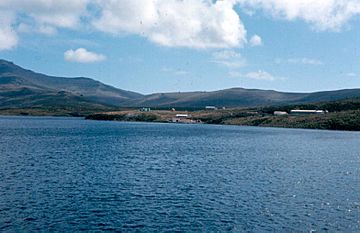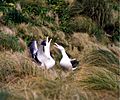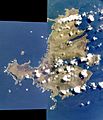Campbell Island / Motu Ihupuku facts for kids
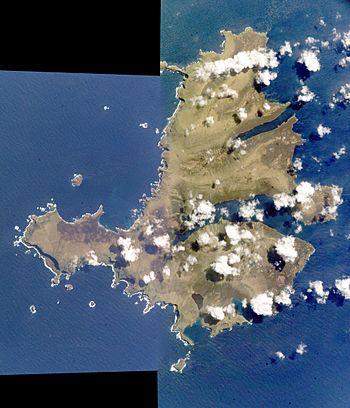
Satellite view
|
|
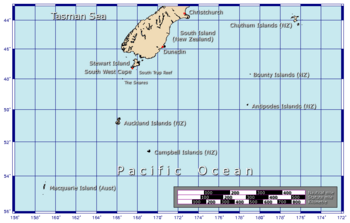
Location of Campbell Island
|
|
| Etymology | Robert Campbell |
|---|---|
| Geography | |
| Location | Pacific Ocean |
| Coordinates | 52°32′24″S 169°8′42″E / 52.54000°S 169.14500°E |
| Archipelago | Campbell Islands |
| Area | 112.68 km2 (43.51 sq mi) |
| Highest elevation | 569 m (1,867 ft) |
| Highest point | Mount Honey |
| Administration | |
| Demographics | |
| Population | Uninhabited |
Campbell Island / Motu Ihupuku is an uninhabited island in the subantarctic region of New Zealand. It is the main island of the Campbell Island group. The island covers about 112.68 square kilometers (43.5 sq mi). Many small islets and rocks surround it, including Dent Island and Jacquemart Island. Jacquemart Island is the southernmost point of New Zealand.
Campbell Island is mountainous, with peaks rising over 500 meters (1,640 ft) in the south. A long, narrow bay called a fjord, named Perseverance Harbour, almost cuts the island in half. This fjord opens to the sea on the east coast.
The island is part of the New Zealand outlying islands. It is directly part of New Zealand but not part of any specific region or district. Instead, it's called an Area Outside Territorial Authority. Campbell Island is also the closest land to the exact opposite side of the Earth from the United Kingdom and Ireland. This means the city furthest away from it is Limerick, Ireland.
Campbell Island is recognized as a World Heritage Site by UNESCO. This means it has special cultural or natural importance and is protected internationally.
Contents
History of Campbell Island
Campbell Island was found in 1810 by Captain Frederick Hasselborough. He was sailing a ship called the Perseverance, which belonged to a company owned by Robert Campbell. The island was named after Robert Campbell. Sadly, Captain Hasselborough drowned in Perseverance Harbour on November 4, 1810, along with a young woman and a boy.
The island quickly became a base for hunting seals. So many seals were hunted that their population was almost completely wiped out. The first big period of seal hunting ended by the mid-1810s. There was a short return of hunting in the 1820s. Seal hunting continued from 1810 until 1912. During this time, 49 ships visited the island for sealing.
Later, in the 1830s and 1840s, whaling became popular here. In 1874, a French scientific expedition visited the island. They came to watch the transit of Venus, which is when Venus passes directly in front of the Sun. Many places on the island are named after people or things from this expedition.
In 1883, a whaling ship called the Sarah W. Hunt was near Campbell Island. Twelve men went to the island in two small boats to look for seals during bad weather. One boat disappeared. The other boat, with six men, managed to reach the shore. The captain of the Sarah W. Hunt thought all the whalers were lost and sailed away. Luckily, a seal protection boat called the Kekeno arrived at the island and rescued the stranded men. The captain's actions caused a big international discussion.
In the late 1800s, the island was used for sheep farming. This continued from 1896 until 1931. The farming stopped because of the Great Depression, a time when the world's economy was very bad. The sheep and a small group of cattle were left behind.
In 1907, a group of scientists spent eight days studying the island. This expedition did a magnetic survey and collected plant, animal, and rock samples.
During World War II, a special station was set up at Tucker Cove. People called coastwatchers worked there to watch for enemy ships as part of the Cape Expedition program.
After a law called the Ngai Tahu Claims Settlement Act 1998 was passed, the island's name was officially changed to Campbell Island / Motu Ihupuku.
In 2012, a group of amateur radio operators visited Campbell Island. They were on a special trip called a DXpedition. The team of ten operators from around the world made over 42,000 radio contacts in eight days.
Weather Station
After World War II, the old coastwatching station became a meteorological station. This is a place where weather is observed and recorded. In 1958, a new base was built at Beeman Cove. This new location was better for measuring weather, especially wind. It also had modern homes for up to 12 full-time staff.
The new weather station (WMO ID 93944) was run by the New Zealand government. Staff worked there for 12 months at a time. They took weather readings every three hours. They also launched hydrogen balloons twice a day to measure the upper air. These weather reports were sent to New Zealand by radio. Besides weather, the staff also measured the earth's magnetic field and studied the aurora australis (Southern Lights). They also tagged Albatross birds and counted Southern Right Whales.
In April 1992, a staff member named Mike Fraser was attacked by a great white shark while swimming at Northwest Bay. He was about 30 meters (98 ft) from the beach. With help from his teammate, Jacinda Amey, Mike made it back to shore. He had serious cuts on both arms. The team kept him alive at the bay, which was about 4 kilometers (2.5 mi) from the main base. A rescue helicopter from Taupo flew to the island to take him to a hospital in Invercargill. This was the longest single-engine helicopter rescue ever done in the world.
Jacinda Amey received the New Zealand Cross. This is the highest bravery award for civilians, given for helping the injured team member. The rescue helicopter pilot, John Funnell, received the New Zealand Bravery Medal.
In 1995, the staff were permanently removed from the station. The manual weather observations were replaced by an automatic weather station. Today, the Royal New Zealand Navy visits the island sometimes to check on the weather station. They also bring conservation staff who do research. Some eco-tourism cruises also visit the island in the summer.
In May 2018, scientists recorded what they believe was the largest wave ever seen in the Southern Hemisphere. It was 23.8 meters (78 ft) tall. A weather buoy near Campbell Island measured this huge wave.
The Legend of The Lady of the Heather
The Lady of the Heather is a romantic novel by Will Lawson. This story mixes facts with made-up events about Captain Hasselborough's death on Campbell Island. The book tells about a daughter of Bonnie Prince Charlie. She is sent away to Campbell Island because people think she betrayed the Jacobite cause.
The idea for her character came from a real woman named Elizabeth Farr. She was likely a "ship girl" who traveled with the crew. Her presence and death in this faraway place inspired the story of The Lady of the Heather.
Climate
Campbell Island has a cold, windy climate known as a maritime tundra climate. The island gets only about 647 hours of sunshine each year. This means it has less than an hour of sunshine on 215 days (59%) of the year. Clouds often cover the island's peaks. It rains a lot, about 1329 mm (52.3 in) annually. Rain, mostly light showers or drizzle, falls on an average of 325 days a year. Sometimes it snows in winter.
It is a very windy place. Wind gusts of over 96 kilometers per hour (60 mph) happen on at least 100 days every year. Temperatures don't change much throughout the day or year. The average yearly temperature is 7°C (44.6°F). It rarely gets warmer than 12.1°C (53.8°F). The warmest temperature ever recorded was 21.2°C (70.2°F), and the coldest was -7.9°C (17.8°F).
| Climate data for Campbell Island | |||||||||||||
|---|---|---|---|---|---|---|---|---|---|---|---|---|---|
| Month | Jan | Feb | Mar | Apr | May | Jun | Jul | Aug | Sep | Oct | Nov | Dec | Year |
| Record high °C (°F) | 21.2 (70.2) |
19.3 (66.7) |
16.1 (61.0) |
15.8 (60.4) |
12.4 (54.3) |
11.3 (52.3) |
10.3 (50.5) |
10.4 (50.7) |
12.7 (54.9) |
15.4 (59.7) |
18.3 (64.9) |
20.0 (68.0) |
21.2 (70.2) |
| Mean daily maximum °C (°F) | 12.1 (53.8) |
12.0 (53.6) |
11.0 (51.8) |
9.7 (49.5) |
8.3 (46.9) |
7.3 (45.1) |
6.9 (44.4) |
7.4 (45.3) |
8.0 (46.4) |
8.9 (48.0) |
9.8 (49.6) |
11.4 (52.5) |
9.4 (48.9) |
| Daily mean °C (°F) | 9.6 (49.3) |
9.5 (49.1) |
8.7 (47.7) |
7.6 (45.7) |
6.1 (43.0) |
5.1 (41.2) |
4.9 (40.8) |
5.2 (41.4) |
5.7 (42.3) |
6.4 (43.5) |
7.1 (44.8) |
8.7 (47.7) |
7.0 (44.6) |
| Mean daily minimum °C (°F) | 7.1 (44.8) |
7.1 (44.8) |
6.4 (43.5) |
5.6 (42.1) |
4.0 (39.2) |
3.0 (37.4) |
3.0 (37.4) |
3.1 (37.6) |
3.5 (38.3) |
3.9 (39.0) |
4.4 (39.9) |
6.1 (43.0) |
4.8 (40.6) |
| Record low °C (°F) | 2.9 (37.2) |
2.3 (36.1) |
0.5 (32.9) |
0.0 (32.0) |
−3.2 (26.2) |
−6.5 (20.3) |
−7.9 (17.8) |
−6.4 (20.5) |
−4.2 (24.4) |
−1.4 (29.5) |
−1.2 (29.8) |
3.2 (37.8) |
−7.9 (17.8) |
| Average precipitation mm (inches) | 112 (4.4) |
106 (4.2) |
122 (4.8) |
115 (4.5) |
131 (5.2) |
104 (4.1) |
106 (4.2) |
103 (4.1) |
113 (4.4) |
110 (4.3) |
100 (3.9) |
108 (4.3) |
1,329 (52.3) |
| Average precipitation days (≥ 1 mm) | 21 | 19 | 27 | 28 | 20 | 18 | 22 | 27 | 25 | 30 | 24 | 29 | 290 |
| Mean monthly sunshine hours | 74.8 | 72.4 | 66.4 | 48.6 | 39.4 | 29.2 | 31.3 | 34.5 | 52.2 | 63.4 | 62.9 | 72.2 | 647.3 |
| Source: NIWA National Climate Database | |||||||||||||
Animals and Plants
Important Bird Area
Campbell Island is a very important place for birds. It is the most important breeding area for the southern royal albatross. The island group is an Important Bird Area (IBA) because many seabirds breed here. It is also home to special birds found only on these islands, like the Campbell teal and Campbell snipe.
Many types of penguins also breed on Campbell Island. These include the yellow-eyed penguin, the rockhopper penguin, and the erect-crested penguin. Other albatross species that breed here are the wandering albatross, the light-mantled sooty albatross, and both the Black-browed mollymawk and the grey-headed mollymawk.
Other birds that live and breed on the island include the sooty shearwater, the grey petrel, and the white-chinned petrel. You can also find the unique Campbell Island shag, the grey duck, the southern skua, and different types of gulls and terns. Land birds like the song thrush, Common blackbird, Dunnock (Hedge sparrow), New Zealand pipit, and starling also live here.
World's Most Remote Tree
Campbell Island is home to what many believe is the world's most remote tree. It is a single Sitka spruce tree, over 100 years old. The next closest tree is more than 222 kilometers (138 mi) away on the Auckland Islands. People think Lord Ranfurly planted this tree between 1901 and 1907.
Conservation Efforts
In 1954, Campbell Island was made a nature reserve. This means it is a protected area. Wild Campbell Island cattle were removed by 1984. Wild Campbell Island sheep were also removed during the 1970s and 1980s, and all were gone by 1992.
In 2001, brown rats (Norway rats) were completely removed from the island. Rats had been on the island for nearly 200 years. This was the largest rat removal project in the world. By 2003, the island was confirmed to be rat-free.
Since the rats were removed, the plants and insects have been growing back. Seabirds are returning, and the Campbell teal, which is the rarest duck in the world, has been brought back to the island. A type of parakeet called Cyanoramphus was found (from old bones) in 2004. There was also evidence of a falcon or harrier.
The Campbell snipe, a type of snipe, was thought to be gone from the main island. But in 1997, it was found on a tiny, rat-free island nearby called Jacquemart Island. After the rats were removed from Campbell Island, the snipe started to move back to the main island.
Marine mammals have also been recovering. Sea lions and southern elephant seals are starting to live on the island again. Some southern right whales still come into the bays in winter to rest or have their babies. This happens especially at Northwest Bay and Perseverance Harbour.
Campbell Island is one of five subantarctic island groups that are World Heritage Sites. This means they are very important natural places protected by UNESCO.
Geology
Campbell Island is actually an old volcanic cone. This means it was once a volcano that is now extinct. Over millions of years, the ocean has worn it down into the shape we see today. The volcano has been extinct for about six million years. For a long time, the island was covered in glacial ice. Because of this, plants could not grow there until about 15,000 years ago.
Research
During World War II, the New Zealand government had people watching the coast on the island. These people were also trained naturalists. They studied the island's geology (rocks and land), plants, and animals.
To celebrate 200 years since the island was discovered, a big research trip called the Campbell Island Bicentennial Expedition (CIBE) took place. This happened from December 2010 to February 2011. It was the largest research trip to the island in over 20 years.
The expedition aimed to learn about the island's human history. They also wanted to see how the plants and insects were recovering after the sheep were removed and the rats were taken away. Scientists studied the island's many streams and the unusual animals that live in them. They also looked at old lake sediments to understand past weather conditions and long-term climate change.
The 50 Degrees South Trust, a group that supports research and education on New Zealand's Subantarctic Islands, ran the expedition. They also work to protect these World Heritage ecosystems. You can find more information about the expedition and its findings on the CIBE website.
Gallery
-
A young male elephant seal resting in the tall grasses
-
New Zealand sea lions playing in the tussock grass
-
A Southern royal albatross with its chick on a nest
-
Campbell Island landscape with large, colorful megaherb plants
-
A Southern royal albatross flying gracefully
-
A pair of southern royal albatrosses
Images for kids
-
Campbell Island / Motu Ihupuku as viewed from the International Space Station
See also
 In Spanish: Isla Campbell (Nueva Zelanda) para niños
In Spanish: Isla Campbell (Nueva Zelanda) para niños


